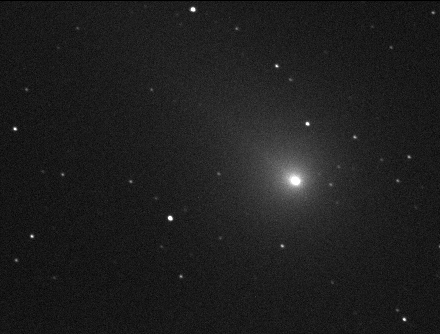|
|
|
|
Comets can be thought of as dirty snowballs. The main nucleus is composed of rocky fragments bound together by frozen substances like ammonia, carbon dioxide, methane and water. The nucleus is surrounded by the head or coma which is made up of dust and gas. When a comet approaches the sun the radiation and solar wind push the dust and gas away from the coma producing the comets tail.
It was the appearance of the comet Hale-Bopp that really got me interested in astronomy. The comet could easily be seen with the naked eye and was a great sight in binoculars. I never did get a chance to see it through a telescope.
Many comets that move around our solar system are very faint and can only be detected by trying to detect their movement against the background stars. This requires observing the target several nights in succession to try and detect the movement. Not an easy feat in the UK with the weather we get. Needles to say I'm still trying to get my first comet!
Anyway here's a picture of Hale-Bopp to show you what can be seen.....

Comet LINEAR C/2000 WM1 is passing through Perseus, heading towards Aries and picking up speed during November, the comet should become an easy target for binoculars and may just reach naked-eye brightness by the end of the December. It is estimated that the comet appears to be brightening by 0.1 magnitude each day.
For observers at mid northern latitudes, Comet LINEAR is well up in the northeast after dusk and remains up all night, nearly directly overhead around midnight. Check out www.heavens-above.com for a finder chart. Southern hemisphere observers will get a better view later in December.
Observation Report - 13 July 2001
| LINEAR C/2001 A2 | |
Well Friday 13th was lucky for me! The sky was clear, very clear. I spent ages searching out objects in Sagittarius and Scutum. Before I knew what was happening it was 1:15am!!! I decided to look for comet linear and was surprised at how high in the sky it was. I could just make it out naked eye. It looked huge in 10x50 binoculars and when I used the scope WOW!!! I used a 9mm eyepiece and a 2x barlow and the nucleus appeared granular! Whilst I was watching I saw some pinpoint size bright flashes similar to sparks. At first I thought that I was seeing things but it happened again about ten seconds later - quite a spectacle!!! I tried to see the tail but failed. I didn't mind - I'd just bagged my first comet. I
watched the comet on the following evening through my binoculars. It was around
midnight and the comet appeared fainter and smaller. This thing is
really moving away fast! |
 |
|
Animation courtesy of Gianluca
Masi
|